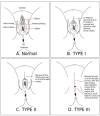Female circumcision debate: A muslim surgeon's perspective
- PMID: 35929872
- PMCID: PMC8260090
- DOI: 10.5152/tud.2021.20546
Female circumcision debate: A muslim surgeon's perspective
Abstract
In this study, we aimed to address female circumcision (FC) from sociocultural, medical, ethical, and religious/Islamic perspectives through the understanding of a Muslim surgeon. FC is performed primarily in Africa today, and its prevalence varies across countries. None of the sociocultural justifications developed historically for FC is scientifically valid. FC provides no health benefits; on the contrary, severely impairs the physical, psychological, and social health of the victim in the short and long term. As for sexual health and satisfaction, the outcome is disastrous. Hoodectomy as another relevant surgical intervention, however, can be distinguished as an exception because it can rarely be for the benefit of the woman. When we assess FC ethically, we see that all of the generally accepted, major principles of biomedical ethics are violated. If we consider FC from an Islamic perspective, the Quran does not contain any verses to ground or adjudicate arguments on FC. The hadiths reporting about the justification of FC have been determined by the hadith scholars to be weak. They have not been accepted as sound justificatory sources that a fatwa can be based on. The author, along with many contemporary Islamic scholars, believes that FC should be abandoned.
Conflict of interest statement
Figures
Similar articles
-
Islamic perspectives on preconception, prenatal, and perinatal counseling.Front Pediatr. 2024 Feb 21;12:1373918. doi: 10.3389/fped.2024.1373918. eCollection 2024. Front Pediatr. 2024. PMID: 38450297 Free PMC article. Review.
-
Hymenoplasty and Muslim Patients: Islamic Ethico-Legal Perspectives.J Sex Med. 2017 Aug;14(8):1003-1010. doi: 10.1016/j.jsxm.2017.06.005. J Sex Med. 2017. PMID: 28760245 Review.
-
Muslim perspectives on palliative care in perinatal and neonatal patients: a mini-review.Front Pediatr. 2023 Jun 13;11:1204941. doi: 10.3389/fped.2023.1204941. eCollection 2023. Front Pediatr. 2023. PMID: 37384311 Free PMC article. Review.
-
Multi-IsnadSet MIS for Sahih Muslim Hadith with chain of narrators, based on multiple ISNAD.Data Brief. 2024 Apr 23;54:110439. doi: 10.1016/j.dib.2024.110439. eCollection 2024 Jun. Data Brief. 2024. PMID: 38756930 Free PMC article.
-
A review of the discussions on cultivated meat from the Islamic perspective.Heliyon. 2024 Apr 2;10(7):e28491. doi: 10.1016/j.heliyon.2024.e28491. eCollection 2024 Apr 15. Heliyon. 2024. PMID: 38601623 Free PMC article. Review.
Cited by
-
The Relationship between Female Genital Mutilation and Infertility: A systematic review and meta-analysis.Sultan Qaboos Univ Med J. 2025 May 2;25(1):310-318. doi: 10.18295/2075-0528.2839. Sultan Qaboos Univ Med J. 2025. PMID: 40641682 Free PMC article.
References
-
- United Nations International Children’s Emergency Fund (UNICEF) Female genital mutilation/cutting: a statistical overview and exploration of the dynamics of change. [Accessed February, 2020]. Available from: www.unicef.org/publications/index_69875.html.
-
- United Nations International Children’s Emergency Fund (UNICEF) The state of the world’s children 2015 executive summary. [Accessed February, 2020]. www.unicef.org/publications/files/SOWC_2015_Summary_and_Tables.pdf.
-
- Wikimedia Commons. FGM prevalence, UNICEF. 2015. [Accessed February, 2020]. https://commons.wikimedia.org/wiki/File:FGM_prevalence_UNICEF_2015.svg.
-
- Oringanje CM, Okoro A, Nwankwo ON, Meremikwu MM. Providing information about the consequences of female genital mutilation to healthcare providers caring for women and girls living with female genital mutilation: a systematic review. Int J Gynaecol Obstet. 2017;136:65–71. doi: 10.1002/ijgo.12057. - DOI - PubMed
LinkOut - more resources
Full Text Sources
Research Materials


